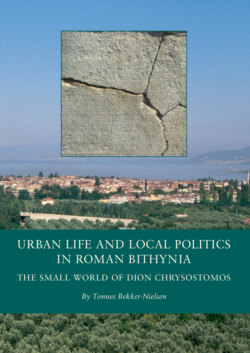Читать книгу Urban Life and Local Politics in Roman Bithynia - Tonnes Bekker-Nielsen - Страница 9
На сайте Литреса книга снята с продажи.
A tale of three cities
ОглавлениеNikomedia, Nikaia and Prusa were important cities in northwestern Asia Minor, located within a hundred Roman miles of Byzantion – later to become the imperial capital of Constantinople – and of each other. Together, they commanded the major highways from Europe into Asia Minor and the Levant. As Hellenistic foundations, they share many common characteristics, and from the Hellenistic period onwards, their histories were intertwined in changing relationships of hegemony and subordination, friendly competition, fierce rivalry or obsessive enmity. Each of them vied for the leading position in their region, and in turn, each of them attained it. Nikaia was the oldest city and the first mêtropolis of Roman Bithynia. Later it was eclipsed by Nikomedia, which rose to be an imperial residence under the Tetrarchy. A thousand years later, Prusa, too, became an imperial capital and the residence of the Ottoman sultan.
During the twentieth century, Prusa and Nikomedia have shared in the industrial growth that has characterized the Marmara region. Whereas a large part of the 34,000 inhabitants of modern Nikaia (Iznik) still nestle within its late Roman walls, Prusa (Bursa) has grown to over a million inhabitants, Nikomedia (Izmit/Kocaeli) to some 300,000.
In the scholarly literature and tourist itineraries, on the other hand, little Nikaia looms far larger than her two sister cities. The last decade has seen two monographs on the history of Nikaia (Foss 1996, P. Guinea Diaz 1997) and it is to Nikaia that visitors go for a visual impression of a Roman city, whereas the remains of ancient Nikomedia and Prusa are covered by modern construction. Though some archaeological evidence has come to light accidentally and in the course of rescue excavations, we have no detailed overall picture of these two cities, their topography and their monuments as we do in the case of Nikaia. This does not preclude writing a history of their urban life and development, it merely means that other types of sources and different approaches are required.
Notes
1 Pol. 1253a1.
2 Proverbs 22.1.
3 Odyssey 9.174-176.
4 Pol. 1296a7.
5 Mem. 4.6.14.
6 Even Sallust (Bell.Jug. 86), no admirer of the Roman nobility, echoes a familiar Roman prejudice when writing that Marius recruited proletarians into the army due to inopia bonorum, literally “a shortage of good ones” (i.e., of propertyowners).
7 Plutarch, Lyk. 13.5; Link 2000, 77-80.
8 Pliny, Ep. 10.34.
9 Or. 40.9; 40.13.
10 Foss 1996, 12-13.
11 Seneca, Ep. ad Lucilium, 83.12-14; Suetonius, Tib. 42; Titus 7.
12 Mouritsen 1988, 67.
13 Cicero, Ad Q.F. 1.1.37-38; cf. Braund 1998, 17-18. In a more positive vein, Pliny (Ep. 9.5) claims to have heard how well his friend Calestrius Tiro is doing as governor of Baetica; but this may merely be a literary formula to open the letter.
14 Coles 1966; Bowman 1971. Some of the later records (from the third century onwards) appear to be verbatim renderings of speeches in the council, probably taken down by a shorthand writer as they were delivered.
15 Mouritsen 1988.
16 Dion, Or. 43.11, but cf. Vielmetti 1941, 98. In Vielmetti’s view, the charge of atheism has no substance but is introduced by Dion to underscore the parallelization of himself with Sokrates in 43.10 and 43.12. Dion evidently intended to answer the charge in 43.13ff, but this part of his oration is not preserved.
